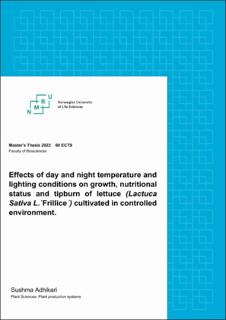| dc.description.abstract | Growth chamber experiments were conducted with Lactuca sativa crisphead lettuce:`Frillice´ growing in nutrient film technique (NFT). The main objective was to study energy-efficient cultivation strategies without reductions in growth and quality. To do this, the effects of temperature, including aerial day temperatures (DT) and night temperatures (NT) as well as leaf temperatures, on the growth, mineral content, and tipburn of lettuce cultivated with different lamp types were investigated. High-pressure sodium lamps (HPS) and two different light emitting diodes (LEDs) suitable for lettuce production (LED I and LED II) were combined with standard (DT/NT: 20/18°C) and varied temperature (DT/NT: 20/13°C) conditions at two different light intensities of 150 µmol/m2/s and 300 µmol/m2/s. The growth and morphology of the plants were recorded together with the tipburn data and leaf temperatures. Mineral analysis was also performed for Ca, Mg, K, Fe, and Mn to see if the changes in content could be linked to tipburn. Higher light intensity was more conducive for tipburn establishment. There was no difference in biomass in lettuces grown under HPS at standard or varied temperatures, but higher tipburn was seen in varied temperatures. Under varied temperatures, LED I (41% red, 13% far-red, and 10% blue) gave better plant growth than HPS but induced more tipburn. Further, the same LED I gave better growth and more tipburn in comparison with LED II (containing 17.23% red, 3.2% far-red, and 21.95% blue) under both standard and varied temperature conditions. The leaf temperature of plants exposed to LED was always lower than plants exposed to HPS (1.53-2.57°C) but were similar between the two LEDs.
In conclusion, the results showed that LED I improved growth compared with HPS and LED II for the growth of plants, but the risk for tipburn is higher to the level that the entire product can be discarded. Lamp types and light intensity are more important in the development of tipburn than air/leaf temperature but did not affect mineral composition very much. Furthermore, the best subset regression did not show high correlations between any of the cations and tipburn. Thus, overall LED I can replace HPS and potentially reduce the energy costs for lighting, but the light intensity should not be high to avoid light stress and tipburn. Though growth was not much hampered, and condensation was not observed, the lower night temperature (13°C) can still cause condensation in the shoot apical meristem and/or guttation due to a higher root pressure and then induce tipburn in greenhouses. Thus, a night temperature >13°C is recommended, together with good control of the air humidity during day and night. | en_US |

